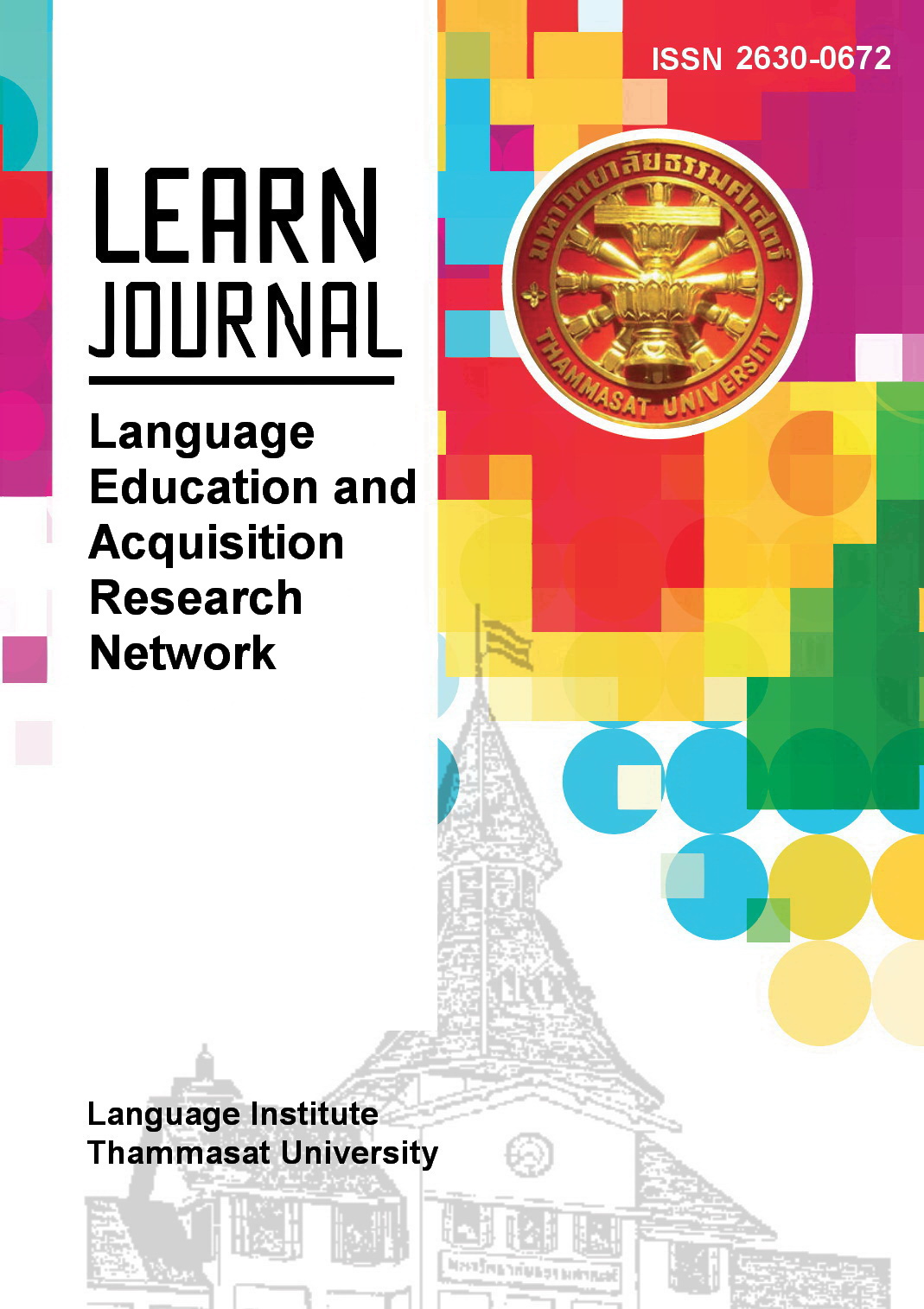Using a Mobile Application to Enhance English Communication Skills of Paramedic Students in the English for Specific Purposes Classroom
Main Article Content
Abstract
The purposes of this study were to 1) develop an English communication mobile application based on emergency medical service situations to meet efficiency criterion E1/E2 = 80/80; 2) compare the students’ English communication skills before and after implementing the mobile application; and 3) examine the students’ attitudes toward the use of the mobile application. The participants were 14 second-year students enrolled in an English for Specific Purposes course. The instruments were 1) a mobile application for English communication, 2) lesson plans, 3) Process E1 and Product E2 tests, 4) a role-play pretest and a posttest, and 5) an attitude questionnaire. The mobile application included videos featuring speakers with different English accents who used English as their lingua franca. Data were analyzed through Means, Standard Deviation, and the efficiency criterion of E1/E2. The findings revealed that the efficiency of the mobile application was 82.50/82.38 higher than the standard criteria (80/80). The students’ English communication skills improved significantly following the use of the mobile application. The students held positive attitudes towards all aspects of the mobile application. The mobile application could prove valuable not only to paramedics but also to other medical professionals dealing with patients from different linguistic backgrounds.
Article Details
References
Abdo, I. B., & Al-Awabdeh, A.-H. (2017). Animated videos prove to be beneficial in teaching English grammar as EFL: A neurological study of how students learn and retain English grammar. Creative Education, 8(9), 1415–1423.
Ahmadi, Dr. M. (2018). The use of technology in English language learning: A literature review. International Journal of Research in English Education, 3(2), 115–125.
Alqurashi, F. (2016). English for medical purposes for Saudi Medical and Health Professionals. Advances in Language and Literary Studies, 7(6), 243-252.
Baker, W. (2012). English as a lingua franca in Thailand: Characterisations and implications. Englishes in Practice, 1, 18-27.
Barnard R., & Zemach, D. (2003). Materials for specific purposes. In B. Tomlinson (Ed.), Developing materials for language teaching (pp. 306-323). Continuum International Publishing Group.
Brahmawong, C. (2013). Developmental testing of media and instructional package. Silpakorn Educational Research Journal, 5(1), 1-20.
Coulehan, J. L., Platt, F. W., Egener, B., Frankel, R., Lin, C.-T., Lown, B., & Salazar, W. H. (2001). “let me see if I have this right …”: Words that help build empathy. Annals of Internal Medicine, 135(3), 221-227.
Decety, J., & Fotopoulou, A. (2015). Why empathy has a beneficial impact on others in medicine: Unifying theories. Frontiers in Behavioral Neuroscience, 8, 1-11.
Deerajviset, P. (2014). Technology in EFL teaching and learning in Thailand: An overview of research and issues. Journal of Mekong societies, 10(1), 71-112.
Demir, K., & Akpınar, E. (2018). The effect of mobile learning applications on students’ academic achievement and Attitudes Toward Mobile Learning. Malaysian Online Journal of Educational Technology, 6(2), 48–59.
Hutchinson, T., & Waters, A. (1987). English for specific purposes: A learning-centred approach. Cambridge University Press.
Huttayavilaiphan, R. (2021). Thai university students’ beliefs about English language teaching and learning and awareness of global Englishes. International Online Journal of Education and Teaching (IOJET), 8(4). 2276-2296.
Kukulska-Hulme, A., & Shield, L. (2008). An overview of mobile assisted language learning: From content delivery to supported collaboration and interaction. ReCALL, 20(3), 271–289.
Lin, Z., Abdullah, A. N., & Samad, A. A. (2022). Exploring Chinese EFL teachers’ acceptance of Mobile-Assisted Language Learning (MALL). International Journal of Information and Education Technology, 12(11), 1172–1178.
Lundqvist-Persson, C. (2017). Empathic communication, its background and usefulness in paediatric care. EC Paediatrics, 6(1), 2-8.
Miyashita, Y., Akaleephan, C., Asgari-Jirhandeh, N., & Sungyuth, C. (2017). Cross-border movement of older patients: A descriptive study on health service use of Japanese retirees in Thailand. Globalization and Health, 13(1), 1-11.
Poengtrummarong, W. (2018). Chinese language needs to communicate with the tourist staff of hotel front office in Muang district, Kanchaburi province. Journal of Administrative and Management, 6(2), 74-79.
Ponglungkha, B., Yiemkuntitavorn, S., & Mejang, A. (2016). The effects of using animation movie to develop speaking ability and satisfaction towards English studying of Matthayom Suksa III students of Phraowitthayakom School in Chiang Mai province. Electronic Journal of Open and Distance Innovative Learning, 6(1), 45-60.
Rezaei, A., Mai, N., & Pesaranghader, A. (2014). The effect of mobile applications on English vocabulary acquisition. Jurnal Teknologi, 68(2), 73–83.
Richards, J. C., & Rodgers, T. S. (2001). Approaches and methods in language teaching. Cambridge University Press.
Sakulsri, T., Nurick, R., & Oeur, I. (2020). Exploring the experiences of Cambodian labor migrants: The journey to Thailand under the framework for bilateral agreements. Journal of Mekong Societies, 16(1), 1–25.
Seidlhofer, B. (2005). English as a lingua franca. ELT Journal, 59(4), 339-341.
Shadiev, R., & Yang, M. (2020). Review of studies on technology-enhanced language learning and teaching. Sustainability, 12(2), 524.
Shortt, M., Tilak, S., Kuznetcova, I., Martens, B., & Akinkuolie, B. (2023). Gamification in mobile-assisted language learning: A systematic review of Duolingo Literature from public release of 2012 to early 2020. Computer Assisted Language Learning, 36(3), 517–554.
Thedpitak, A., & Somphong, M. (2021). Exploring Thai EFL learners’ attitudes toward the use of mobile applications for language learning. LEARN Journal, 14(1), 370-398.
Todd, R.W. (2018). Analyzing and interpreting rating scale data from questionnaires. REFLections, 14, 69–77.
Wattananukij, W., & Crabtree, R. B. (2020). Language attitudes toward Philippine English: A comparative study among Thai undergraduate students with and without exposure to Philippine English teachers. NIDA Journal of Language and Communication, 25(37), 18–40.


